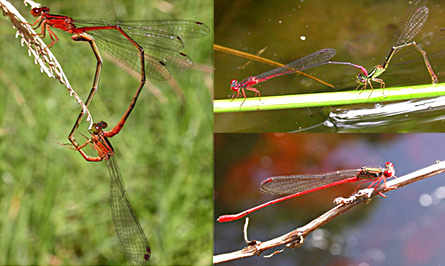It’s not the sexual harassment. It’s the sunshine.

That’s Idelle Cooper’s new take on the evolutionary force driving female Hawaiian damselflies to mimic males.
The long, slim bodies of male Megalagrion calliphya damselflies shine fire-engine red, says Cooper of Indiana University in Bloomington. For the species as a whole, about half the females have grass-green bodies and others sport the brilliant guy-red, Cooper reported.
Such cross-dressing females that mix in with girlier girls also show up among insects, lizards and birds. Biologists have typically explained the benefit of this male mimicry as reducing the relentless interference from sex-obsessed males.
For these damselflies, though, annoying propositions may not have much to do with the colors, Cooper reported June 23 in Minneapolis during the Evolution 2008 meeting. She finds that the benefit to cross-dressing may be plain old adaptation to habitat.
Males and females of this Hawaiian species spend most of their time in neighboring but separate worlds. The males stake out territories around exposed streambeds, defending them against other males and waiting for a female to drop by.
The females visit the males’ bit of stream when it’s time to mate and lay eggs in the water. Otherwise the females stay in adjacent shrubbery.
In damselfly populations where females spend most of their time in landscapes that are as sunny and exposed as male territories, the sexes tend to share the same bright red, Cooper said.
Cooper studied his-and-her habitats in eight populations at different altitudes on Hawaii’s BigIsland. In the lowlands, Cooper found hardly any females sporting male-red coloring. The masculine-looking percentage grew with altitude. In the heights, she found no green females.
Female habitats differed too with altitude. Cooper’s measurements of canopy cover found ample shrubbery near streams in the lowlands, offering plenty of shade. Plant growth dwindled as elevation soared, leaving only sparse cover at the heights. There, the females’ realm was almost as sunny and exposed as the males’ territory.
Published climate data, Cooper said, showed that the most intense solar radiation blasts the heights and then tapers off as altitude drops.
To check for an impact of changing exposure to sun, Cooper measured the red by catching damselflies, scanning them digitally and evaluating the hue using PhotoShop. The habitat did correlate with the color: Red damselflies tend to be redder if their home is higher, Cooper said.
Other work suggests that red pigments defuse potentially damaging free radicals in tissues exposed to sun.
For a rough test of the effect, Cooper turned to a classic floatation test. She ground the thorax body sections of damselflies to create a slurry and then soaked paper disks with that slurry.
Then she dropped disks into a great source of free-radicals, hydrogen peroxide. As substances in the slurry reacted with the hydrogen peroxide, the disks floated. The stronger the reaction, the sooner the disks floated — in those slurries, antioxidants quickly reacted with and neutralized the free radicals.
“This is biology on a budget,” Cooper said.
With this method, the slurries from redder damselflies indeed looked as if they carried more power against free radicals, she said.
The females wearing red thus seem to responding to the same environmental pressures that favor males becoming red. The malelike female “is actually not a mimic of the male,” she concluded.





